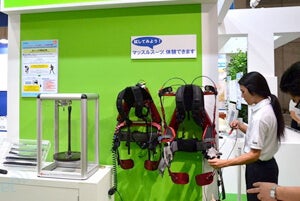New Upper Body Bionic Suit Uses Air to Lift Loads of 50 Kilograms

Share
The University of Tokyo’s latest robot suit can help humans lift heavy loads using naught but air. How exactly? Instead of complex, heavy electronic actuators, the suit uses simpler pneumatic artificial muscles (PAMs). These rubber bladders contract when filled with air, mimicking human muscles, to lift weights upward of 50 kg.
At just 9 kg, build team leader Hiroshi Kobayashi says the suit’s, “power-to-weight ratio is 400 times greater than motor-driven suits.” That’s pretty impressive! A lighter rig requires less power, potentially allowing the suit to outlast its rivals in the field.
Further, the suit’s novel approach may bring down the cost. The team hopes to make their exoskeleton commercially available next year for under $200 a month. Compare that to the Ekso bionic legs’ $140,000 up front cost and $10,000 annual servicing fee. Or HAL’s $1,500 a month rental price tag.
The suit is promising to be sure, but in watching the demos, you might notice a few drawbacks to the current configuration.
First, it’s tethered—the suit needs to be plugged in, limiting its range and maneuverability. Now, undoubtedly, a battery pack would solve that issue. And simply. But that the suit is still tethered seems to indicate it is yet earlier in the design process than a release date of next year would suggest.
Another awkward item. The device’s pneumatic muscles must be actuated manually—currently a button is held and pressed by one of the students. Compare this method to Japanese rival Cyberdyne’s HAL exoskeleton that senses motor neuron impulses through the skin to anticipate motion.
Finally, the suit is intended for lifting heavy loads yet provides limited support for the user’s legs. In the video, a test subject notes his arms and back feel fine—but his legs feel the full weight. Minimal leg support limits where and for how long loads can be carried.
See the suit in action here:
Be Part of the Future
Sign up to receive top stories about groundbreaking technologies and visionary thinkers from SingularityHub.


These design flaws don’t mean the team will never get there—merely that a touch of skepticism about a commercial release next year might be warranted.The prototype was first demonstrated in 2009 with an expected commercial release in 2010.
Since then, it appears some moderate improvements have been made—heavier duty materials, a slick new paint job, and casing for the air bladders. But the general functionality remains the same. Still lifting 50 kilograms. Still controlled manually by button. The suit no longer looks like a prototype, but it appears to be on the slow track to full commercial readiness.
Regardless of how soon the suit goes into production, the PAMs are an interesting innovation. Combined with other advanced features in suits like Hulc, HAL, XOS 2, or Ekso, might we see lighter, less power hungry suits in the future? Hopefully. Sometimes an innovative idea is perfectly executed by the inventor, sometimes it is best combined with other inventions.(Or as, we pointed out back in 2009, this technology might simply serve a different demographic.)
Either way, consider the progress in bionics over the last few years: We have working bionic hands, bionic arms, bionic legs (multiple versions: here, here, and here), and full-body bionic suits (here, here, and here). Even thought-controlled bionics!
To say things are moving quickly is a bit of an understatement. Ultimately, we might all have an exoskeleton hanging next to our rain coat in the closet. What? It's possible!
Jason is editorial director at SingularityHub. He researched and wrote about finance and economics before moving on to science and technology. He's curious about pretty much everything, but especially loves learning about and sharing big ideas and advances in artificial intelligence, computing, robotics, biotech, neuroscience, and space.
Related Articles

This Light-Powered AI Chip Is 100x Faster Than a Top Nvidia GPU

These Robots Are the Size of Single Cells and Cost Just a Penny Apiece

How Scientists Are Growing Computers From Human Brain Cells—and Why They Want to Keep Doing It
What we’re reading


